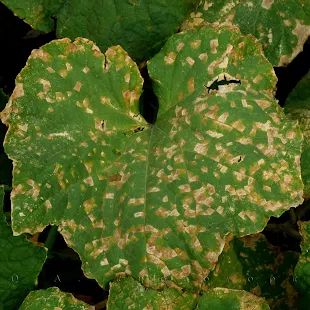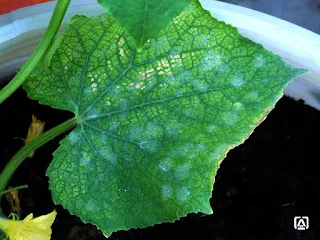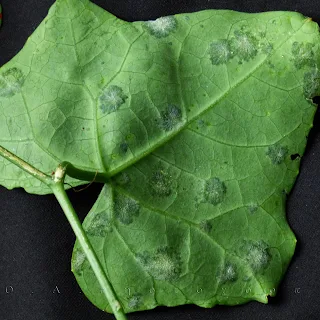Downy mildew of cucurbits
Host: Cucumber (Cucumis sativus L.)
Pathogen: Pseudoperonospora cubensis (Berk. & Curt.) Rostov
Pathogen: Pseudoperonospora cubensis (Berk. & Curt.) Rostov
Distribution
Downy mildew is one of the most devastating diseases of the cucurbits with worldwide distribution. The disease was first reported by Berkeley and Curtis from Cuba in 1868. Since then, the disease has been reported in several countries, such as the Americas, Europe, Japan, Australia, South Africa, the Middle East, and the Indian subcontinent. The disease becomes destructive in warm and humid climates, which provide ideal conditions for the fungal pathogen.
Symptoms
 |
| Foliage of cucumber infected with Downy mildew |
 |
 |
| Angular lesions caused by Downy mildew | Leaf necrosis caused by Downy mildew |
Symptoms of the disease are confined
to the leaves, where they appear in the form angular lesions. Under favorable
conditions (i.e., dew or irrigation), lesions become water-soaked, which later
on become chlorotic and necrotic. At this stage, the plant cell dies and curls-up.
This stage is marked as ‘wildfire’ because of the burned appearance of foliage. Although the fructifications are not infected, however, heavy loss in yield occurs because
of a reduction in the photosynthetic area of leaves.
Pathogen
Downy mildew of cucurbits is caused by Oomycetous fungus, Pseudoperonospora cubensis. It is an obligate parasite
or biotrophs. Fungus produces singly borne sporangiophores, which terminate into pointed tips at acute angles. Large, conspicuous lemon-shaped sporangia are born
on the tip. The sporangium has an apical papilla. The surface of the sporangium is
finely decorated. Sexual reproduction in this fungus is rare (Colucci et al.,
2010).
Control measures
- Reduced humidity and proper airflow between the leaves reduce the disease severity.
- The pathogen very rapidly acquire resistance towards the fungicides. Hence, multiple fungicides on a rotation basis should be applied under controlled environmental conditions, possibly by integrating with other measures.
- Wild cucumber (Cucumis metuliferus L.) and IIHR-438 genotype of cucumber have been shown to be resistant against downy mildew in the tropical climate of India (Bommesh et al., 2018).
References
- Bommesh, J.C., Pitchaimuthu, M., Sadashiva, A.T., Sriram, S., Varalakshmi, B. and Ravishankar, K.V., 2018. Identification and confirmation of downy mildew (Pseudoperonospora cubensis Berk. & Curt.) resistance sources in cucumber (Cucumis sativus L.). Indian Phytopathology 71(3), pp.337-348.
- Colucci, S.J. and Holmes, G.J., 2010. Downy mildew of cucurbits. Downy mildew of cucurbits. DOI: 10.1094/PHI-I-2010-0825-01
Powdery mildew of cucurbits
Host: All the plants of family Cucurbitaceae
Pathogen: Podosphaera xanthii (syn. Sphaerotheca fuliginea) and Golovinomyce cucurbitacearum (syn. Erysiphe cichoracearum)
Pathogen: Podosphaera xanthii (syn. Sphaerotheca fuliginea) and Golovinomyce cucurbitacearum (syn. Erysiphe cichoracearum)
Distribution
Powdery mildew of cucurbits is distributed throughout the world, wherever cucumbers, watermelons, pumpkins, squashes, and gourds are grown. The disease has been extensively studied in the Punjab state of Northern India by Gupta and Sharma (2012) and in Florida by Nuñez-Palenius et al. (2006).
Symptoms
 |
 |
| Powdery mildew affected cucumber leaf | Powdery mildew on upper surface of infected leaf |
 |
 |
| Powdery mildew on lower surface of infected leaf | Powdery mildew on infected stem |
The disease is very easy to
identify as the pathogen covers the leaves and stems in the form of white pad
of mycelium. Powdery mildew appears first on older stems and leaves of cucurbits. A white powdery mass of fungal mycelium appears on both leaf surfaces, stems, and petioles. In severe infections, the disease can cause premature death of leaves and reduce yield and fruit quality. Premature death of a plant can also occur.
Pathogen
More than one fungal pathogen is reported to incite the disease. Gupta and Sharma (2012) reported that Podosphaera xanthii (syn. Sphaerotheca fuliginea) and Golovinomyces cichoracearum (syn. Erysiphe cichoracearum) are responsible for causing powdery mildews in cultivated and wild Coccinia cordifolia, respectively, in Punjab, Northern India.
Control measures
- A spray of sulfur- and copper-based fungicides prevents plants from powdery mildew.
- It can be controlled by spraying wettable sulfur @ 0.2%.
- Resistant cultivars of cucurbits should be grown.
- The plantation of cucurbits in areas with proper aeration is helpful. Shade favors the disease.
- Avoid overdosing on nitrogenous fertilizers.
References
- Gupta, M.K. and Sharma, G.K., 2012. Species composition of powdery mildew on cucurbits in Punjab, India. Asian Journal of Microbial. Biotech. & Env. Sc, 14, pp.257-262.
- Nuñez-Palenius, H.G., Hopkins, D. and Cantliffe, D.J., 2006. Powdery mildew of cucurbits in Florida. IFAS Extensions-University of Florida, pp.1-9.
Content first created on 02-09-2020
last updated on 15-03-2025
last updated on 15-03-2025





0 Comments
Leave your comments here.